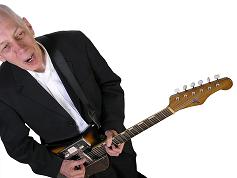|
Rod Clements saw considerable chart success with folk-rockers Lindisfarne, penning their hit Meet Me On The Corner. He currently works as a solo artist, with his band, The Ghosts of Electricity, and in collaboration with other musical kindred spirits such as Bert Jansch, Michael Chapman, and Rachel Harrington. We trust you’ll enjoy the latest of Rod’s musings in which you'll find he’s
NICELY OUT OF TUNE

Walking down the busy street, my ears are assailed by the sound of a busker murdering Wonderful Tonight at 10 o’clock in the morning. His voice, guitar and pre-recorded backing track are all emanating from a small practice-amp which is hopelessly inadequate for the task and the result is a grim cacophony which no amount of built-in digital reverb can alleviate. I hurry past, glimpsing cowboy hat and music stand, trying not to catch his eye. A little further on, before Clapton’s representative on earth is entirely out of earshot, I enter the range of a saxophonist improvising stridently over a jazz-funk track coming out of a boombox placed on the pavement next to him. It sounds like what you hear coming out of other people’s headphones on the bus, only louder.
At one time, buskers had to be on the lookout for the police and be prepared to grab their money and run. (Nobody who witnessed it would ever forget the sight or sound of a one-man band in flight from the law.) This imposed a useful limitation on buskers’ equipment and thus the amount of noise they were able to produce. Take away that constraint and you open the floodgates for amplifiers, boomboxes, music stands and all the rest.
It’s not just buskers. Come Saturday, the shopping precinct becomes the arena for an all-out battle of the bands. At one end, the Peruvian pan-pipe ensemble with their PA system and CD stall. At the other, the African new-age evangelical gospellers dishing out salvation and leaflets. And in the middle, a gaggle of tweenies in matching t-shirts hammering away on their steel drums for charity. If any of these outfits had to pack up and leave in a hurry, they’d need a team of roadies and a couple of trucks.
I’ve got nothing against live music being played in the street . It should provide joy and colour in a grey landscape and remind us that there’s more to life than business and shopping. Some of the world’s greatest folk and blues musicians have worked the streets at one time or another. But too much of what the public hears now is just karaoke performed by average players over store-bought backing tracks, reproduced too loudly through cheap amplification, and it sounds like what it is – aural pollution.
When I lived in London in the 1970s, there was a story going round that the old wartime air raid sirens (many of them still there on the tops of buildings) had been tested to see if they could be used in the event of a flooding alert (this was just before the Thames Barrier came into operation). Apparently the sirens had worked fine, but nobody had been able to hear them in the street because of the increased noise of traffic, piped music from shops and so on. And this was before buskers had amplifiers and PA systems, so the poor old sirens wouldn’t stand much of a chance now. Amplified music in a public street forces itself on people just as piped muzak does, regardless of whether or not they want it. Acoustic music finds its natural place in the aural environment, and its best exponents become favourites of the regular passer-by. The uilleann piper in the arcade, the quartet with the double bass who look like they’ve parachuted in from 1930s Paris, and the Don Partridge lookalike with the harmonica and battered twelve-string can usually expect something from me. As for the Clapton impersonator and the sax player with the boombox, all I’ll be giving them is as wide a berth as possible.
|